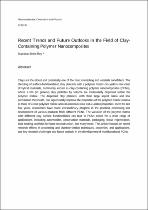 ResearchSpace
ResearchSpace
Recent trends and future outlooks in the field of clay-containing polymer nanocomposites
JavaScript is disabled for your browser. Some features of this site may not work without it.
- ResearchSpace
- →
- Research Publications/Outputs
- →
- Journal Articles
- →
- View Item
| dc.contributor.author |
Ray, Suprakas S

|
|
| dc.date.accessioned | 2014-09-05T12:55:05Z | |
| dc.date.available | 2014-09-05T12:55:05Z | |
| dc.date.issued | 2014-06 | |
| dc.identifier.citation | Ray, S.S. 2014. Recent trends and future outlooks in the field of clay-containing polymer nanocomposites. Macromolecular Chemistry and Physics, vol. 215(12), pp 1162- 1179 | en_US |
| dc.identifier.issn | 1022-1352 | |
| dc.identifier.uri | http://onlinelibrary.wiley.com/doi/10.1002/macp.201400069/abstract | |
| dc.identifier.uri | http://hdl.handle.net/10204/7658 | |
| dc.description | Copyright: 2014 Wiley. This is an ABSTRACT ONLY. The definitive version is published in Macromolecular Chemistry and Physics, vol. 215(12), pp 1162- 1179 | en_US |
| dc.description.abstract | Clays are the oldest and potentially one of the most interesting and versatile nanofillers. The blending of surface-functionalized clay platelets with a polymer matrix can yield a new class of hybrid materials, commonly known as clay-containing polymer nanocomposites (PCNs), where 1–5% (in general) clay particles by volume are molecularly dispersed within the polymer matrix. The dispersed clay platelets, with their large aspect ratios and low percolation thresholds, can significantly improve the properties of the polymer matrix relative to those of a neat polymer matrix and can introduce new value-added properties. Over the last few years, researchers have made extraordinary progress in the practical processing and development of various products from different PCNs. The variation of the polymer matrix with different clay surface functionalities can lead to PCNs suited for a wide range of applications, including automobiles, construction materials, packaging, tissue regeneration, load-bearing scaffolds for bone reconstruction, and many more. This article focuses on recent research efforts in processing and characterization techniques, properties, and applications, and key research challenges and future outlook in the development of multifunctional PCNs. | en_US |
| dc.language.iso | en | en_US |
| dc.publisher | Wiley | en_US |
| dc.relation.ispartofseries | Workflow;13399 | |
| dc.subject | Clays | en_US |
| dc.subject | Nanofillers | en_US |
| dc.subject | Clay-containing polymers | en_US |
| dc.subject | Nanocomposites | en_US |
| dc.subject | PCNs | en_US |
| dc.title | Recent trends and future outlooks in the field of clay-containing polymer nanocomposites | en_US |
| dc.type | Article | en_US |
| dc.identifier.apacitation | Ray, S. S. (2014). Recent trends and future outlooks in the field of clay-containing polymer nanocomposites. http://hdl.handle.net/10204/7658 | en_ZA |
| dc.identifier.chicagocitation | Ray, Suprakas S "Recent trends and future outlooks in the field of clay-containing polymer nanocomposites." (2014) http://hdl.handle.net/10204/7658 | en_ZA |
| dc.identifier.vancouvercitation | Ray SS. Recent trends and future outlooks in the field of clay-containing polymer nanocomposites. 2014; http://hdl.handle.net/10204/7658. | en_ZA |
| dc.identifier.ris | TY - Article AU - Ray, Suprakas S AB - Clays are the oldest and potentially one of the most interesting and versatile nanofillers. The blending of surface-functionalized clay platelets with a polymer matrix can yield a new class of hybrid materials, commonly known as clay-containing polymer nanocomposites (PCNs), where 1–5% (in general) clay particles by volume are molecularly dispersed within the polymer matrix. The dispersed clay platelets, with their large aspect ratios and low percolation thresholds, can significantly improve the properties of the polymer matrix relative to those of a neat polymer matrix and can introduce new value-added properties. Over the last few years, researchers have made extraordinary progress in the practical processing and development of various products from different PCNs. The variation of the polymer matrix with different clay surface functionalities can lead to PCNs suited for a wide range of applications, including automobiles, construction materials, packaging, tissue regeneration, load-bearing scaffolds for bone reconstruction, and many more. This article focuses on recent research efforts in processing and characterization techniques, properties, and applications, and key research challenges and future outlook in the development of multifunctional PCNs. DA - 2014-06 DB - ResearchSpace DP - CSIR KW - Clays KW - Nanofillers KW - Clay-containing polymers KW - Nanocomposites KW - PCNs LK - https://researchspace.csir.co.za PY - 2014 SM - 1022-1352 T1 - Recent trends and future outlooks in the field of clay-containing polymer nanocomposites TI - Recent trends and future outlooks in the field of clay-containing polymer nanocomposites UR - http://hdl.handle.net/10204/7658 ER - | en_ZA |





